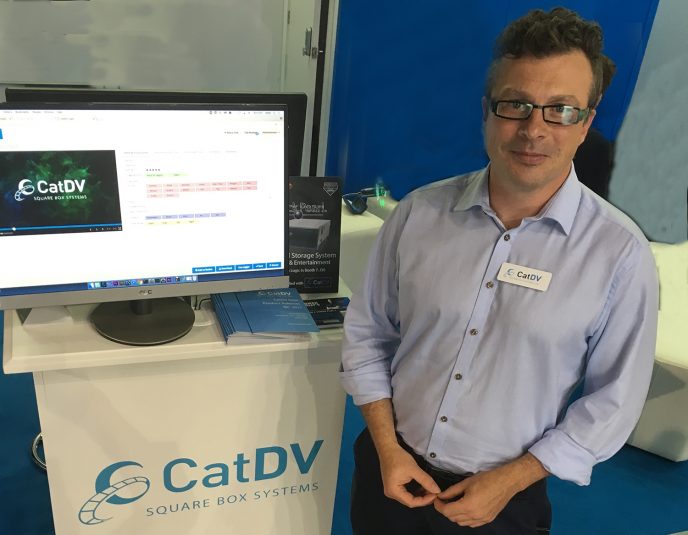IBC Reflections: Square Box Systems CEO Dave Clack on How CatDV Opens Up MAM for Sports Organizations
Upgrades offer enhanced flexibility in deployment, simplified workflow
Square Box Systems headed to IBC 2017 with the latest version of its flagship CatDV media-asset–management (MAM) system in tow. Among its highlights is a new plug-in architecture for CatDV Worker 7, the platform’s general-purpose automation engine, which enables users to build customized workflows and automate file processing.
SVG sat down with Square Box Systems CEO Dave Clack at the show to discuss this version of CatDV and how Worker 7 helps streamline its workflows, where he’s seeing the most significant growth in the sports-production market, and how his team works with sports organizations that don’t have MAM experts to build out their unique workflows.
What are you highlighting here at IBC?
Our big news is the launch of Worker 7, which includes a load of upgrades on CatDV, including a new web client. Worker is now cloud-friendly, virtualization-friendly, Linux-friendly, and, in addition, has a slick new graphical workflow design. It’s a lot more flexible in terms of deployment options, particularly Linux cloud and hybrid cloud. And it’s got a great new user experience with a colorful, intuitive workflow builder.
There are also some architectural changes and new plugins. We have a new file-path cleaner, or we can automate archive jobs just by dragging an activity from the palette of tools onto the workflow. That makes it really easy. Then, all the other bits of product — the server, the install client, and the desktop client –have improvements.
Particularly [of note] for sports, we now have the ability to link fields together for searching. Let’s imagine you’ve got a home and away field. Or maybe you have three different athletes involved in one play, and you want to search specifics about each. Being able to have that metadata stored separately but then be able to search across it is really very powerful for sports. The other [new feature] that’s very sports-oriented is our live logger, which allows you to do pushbutton logging for [moments] like a goal or touchdown to simplify the workflow and allow you to log lots of metadata in almost real time.
In what areas of the sports market is CatDV seeing growth right now?
I love the way that CatDV can help people make the content-creation process for sports better. [For example,] you’re not just looking at the shots from today’s game to be making tonight’s shows; you’re using this as part of the historic record. After some simple logging and tagging, suddenly the history of the team is completely available to everyone in your organization: the production team, the social-media teams, the coaches and sports-science folks, and everyone else across the organization.
We have a lot of NFL, NBA, soccer, basketball, baseball, hockey teams using CatDV. And the more we talk to them, the more we see there’s opportunity for them to expand what they do. There’s a near-infinite demand from the fans [for] high-quality content and programming — whether it’s professional sports, college sports, or something [lower-level] — but there’s not an infinite amount of money to pay for it. cost-effective solutions that can help create high-quality programming very cost-effectively is what CatDV does best. So we see plenty of opportunities for customers and prospects to save time, money, and stress by using our [platform].
Many CatDV users are smaller sports organizations without much experience in media-asset management. How are you helping to educate these beginners on best practices for CatDV and MAM as a whole?
We have a professional-services capability that enables us to get out there, learn what customers are doing, and then we learn ourselves and can share that best practice. We have been a part of some great deployments across sports, and, when you realize how one customer’s doing something, it’s very easy to take that information and use it in the future. We can tell customers, “We’ve seen this problem solved in four different ways, and here are the strengths and weaknesses, so maybe you should consider this solution.”
We really are harvesting best practices by getting out there and engaging with our customers. I think it gives us a unique perspective across the sports industry. We have found ourselves learning something from snooker and sharing that with folks who are doing college athletics in the U.S. The same principles apply, but these are folks that wouldn’t necessarily get together and share ideas.
Many of your sports clients’ systems may start out small, but their MAM workflows and ecosystem will only grow. How do you aid them in this expansion?
It’s true that many start small and grow from there. You can get into a CatDV system for less than a thousand dollars, but our biggest systems are quite sophisticated and, therefore, costly. It takes people time to understand what asset management can do for their business.
Some of our best customers started off with a pretty small system and, after a year, decided to expand it out to include not just finished assets but also work assets. Then, next year, they want to share their content with their colleagues at other teams. And then on and on from there. So having a software product that can grow with our customers is key.
Secondly, we choose our consulting services and our dealer network very carefully because they understand the business and they can offer good advice to get people started. CatDV can be deployed in a whole pile of ways, so that guidance is very important. You need to get under the skin of it: what’s the problem? where’s the waste? where’s the time, money, and stress being thrown away in this process? Once those problems are identified, then it’s up to us and our partners to solve them.

